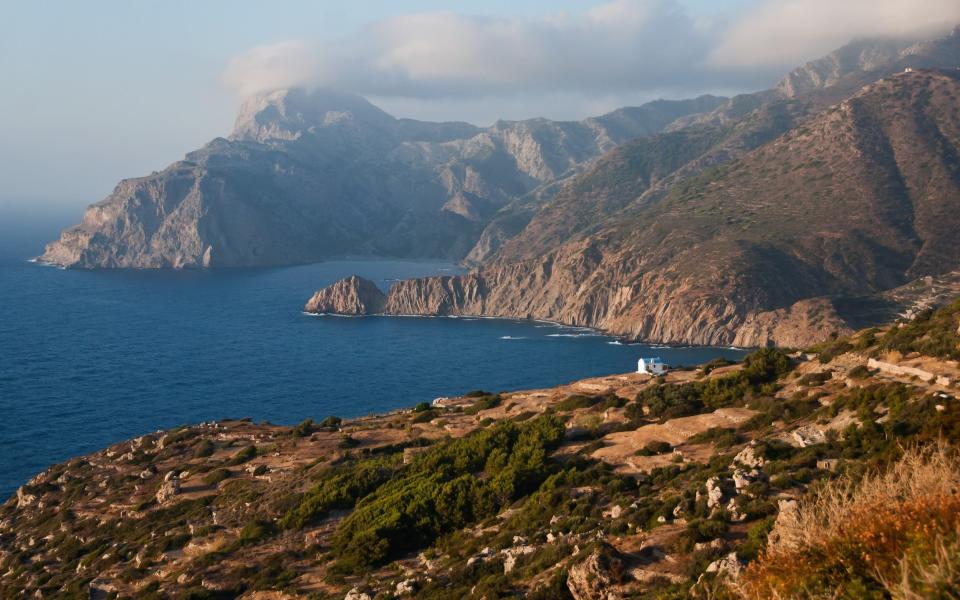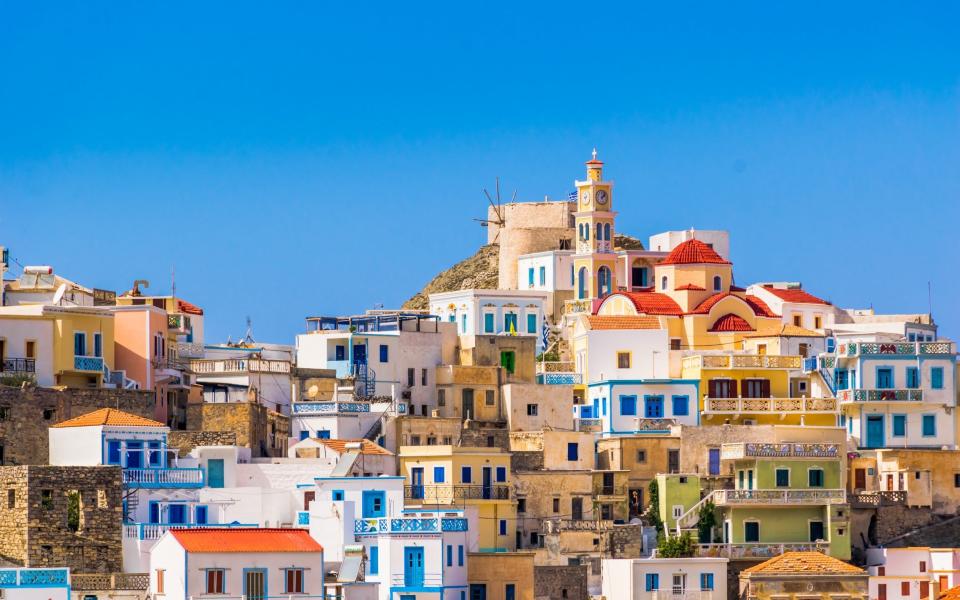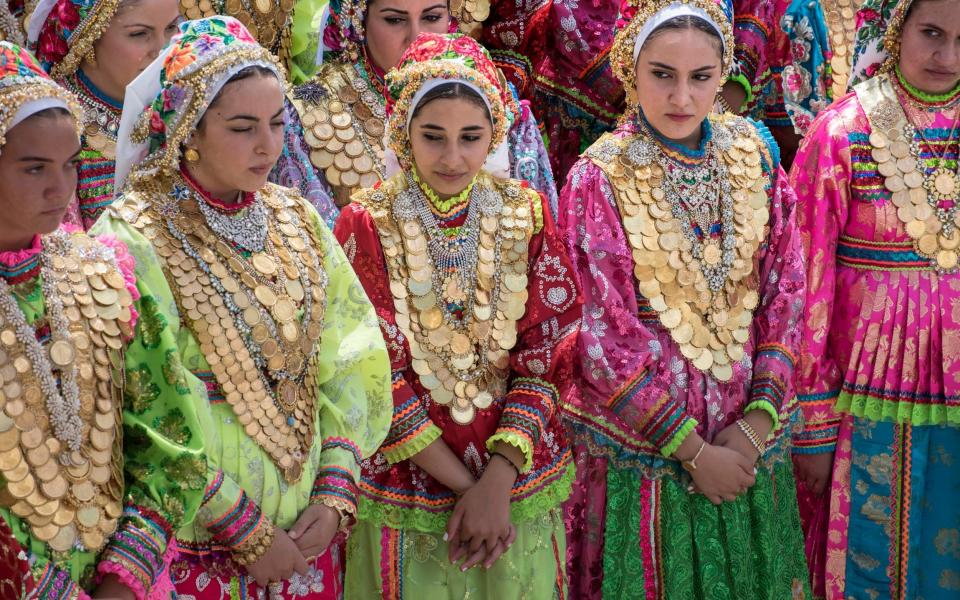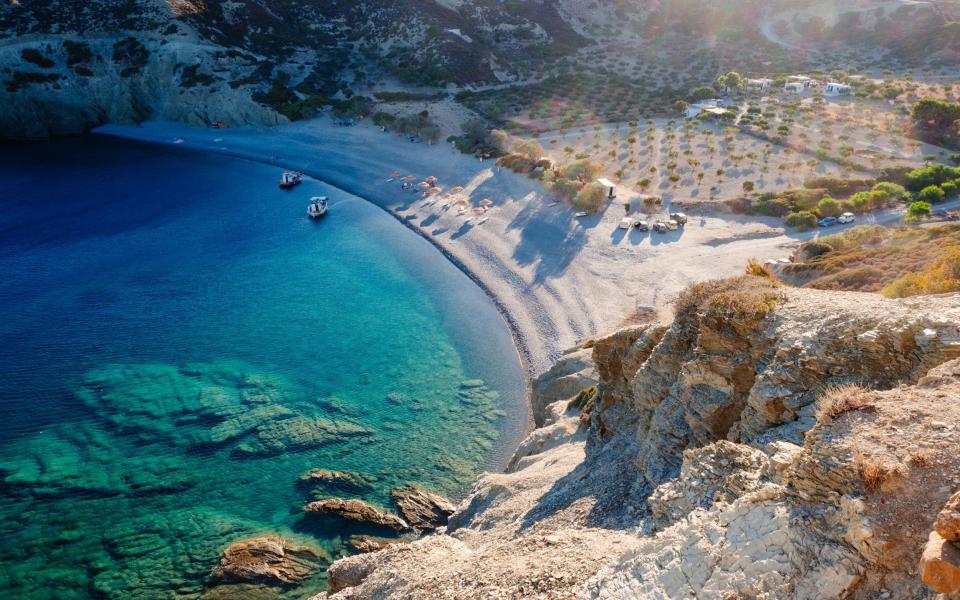The Greek island lost to time – where women rule the roost

Boulders the size and shape of a Stegosaurus’ dermal plates snagged at my jeans as I followed guide Dinos Protopapas along a steep cliff face where Eleonora’s falcons banked and swooped on boomerang wings above a cluster of dome-roofed buildings. “Those were the houses of Genovese pirates – my ancestors – who lived here on Saria Island,” Dinos told me.
He explained that Saria – now separated by a narrow channel of water, but once part of the much larger island of Karpathos – had a thriving pirate population in the 10th century. “Pirates have had a big influence on Karpathos,” he added, before giving a strangled yodel – like Johnny Weissmuller in those old Tarzan movies – and diving from a rocky peak into sea the colour of turquoise glass. Exploring Karpathos the following day, along a road framed by pine-furred mountains and fringed by tahini-coloured beaches, I discovered the truth of his words.
As the road zigged and zagged some 30 miles from capital Pigadia in the southeast towards Diafani on the island’s northern tip, I caught tantalising glimpses of the island’s villages. Built to discourage incursions from Sarian pirates, they were scattered across slopes so steep you’d need to be a goat (or a Karpathian) to climb them.

Although Karpathos was mentioned by Homer in the Iliad (in a classic typo he referred to it as ‘Krapathos’), the second largest of Greece’s Dodecanese islands is rarely found on tourist radars and Diafani – its remotest seaside resort – doesn’t have too many hotels. Like most of the others, with its pimply stucco-rendered façade, warped blue shutters and rooms linked by alleys where stray cats roam, hotel Glaros was a bit of a time warp.
My room was dark, my bed tiny and my mattress hard. These slight discomforts were more than made up for, however, by a large balcony with wraparound views of Diafani’s long pebbled beach fronted by bottle green water, and breakfast: moist spinach pies cooked the night before by the owner’s black-clad grandmother, alongside bread hot from the oven and homemade jam. “We don’t have many shops here – we have to grow and make everything ourselves,” owner Maria told me. Apart from Homer and pirates, Karpathos has two other claims to fame.
Matriarchal mountain villages
According to legend this wild isle was the birthplace of Japetus, Titan god of mortality; it’s also home to Olympos, a unique mountain village where women – who still dress in colourful traditional costumes – are said to rule the roost. I met Mixalis Reissis from local company Karpathos Travel the following afternoon.
Now in his thirties, Mixalis was born on the island. He told me that Olympos was cut of from the world – and even from the rest of the island – until the 1980s, when a road was built. “Until then they didn’t even have electricity – you’ll meet people in their fifties who still remember when there was no TV and the only light came from candles and oil lamps,” he told me, as we drove towards this high-flung mountain village five miles from Diafani.

Seen from afar, with its jumble of sorbet, peach, pale plum and faded lemon houses scattered across two low hillsides, Olympos had the symmetry and colour of a Battenberg cake. Close up, however, it was a frenetic labyrinth of lanes and passageways lined with shops selling ceramic dishes and brightly coloured hand-woven tablecloths, next to tavernas with vine-shaded terraces, blue caned chairs and tweeting birds, sadly, in ornate cages.
We climbed granite steps as big as railway sleepers, dodging sinuous men carrying sacks of potatoes, crates of tomatoes and even a loudly bleating goat. “It’s feet or donkeys here,” Mixalis said. I expected the costumed women to be a gimmick – just something to lure tourists – but even in early summer, with few foreign visitors, there were plenty of colourfully-clad residents.
Traditional dress and arranged marriages
Groups of younger women wearing bright sequinned headscarves and stiffly pleated sakofoustano skirts flitted past older women clad in the traditional black kavai overcoats and darker headgear. Taverna owner Mangafoula showed me her own costume. “I have different ones according to different days and then special ones for festivals,” she told me.
As a married woman she wore fewer colours: a headscarf embroidered with flowers and a dark-coloured sakofoustano edged with colourful ribbon. Even though it was 30C outside, she also wore the traditional red-toed knee-length boots made from butter-soft, but sturdy, kidskin. I asked her why the men didn’t wear traditional clothing. She laughed: “Because we are the most important!

Unlike elsewhere in Greece, here in Olympos it’s the first-born girl who is the sole heir to the family fortune, so it’s the women who must maintain all the traditions.” She showed me her parent’s house: one room, its walls lined with ceramic jugs, floors covered with bright woollen rugs and a bed on a high dais which was rolled up during the day like a plump futon. We sat at a gleaming table and Mangafoula served us meze – fat Kalamata olives and creamy split pea puree fava with dakos bread rusks – whilst Mixalis told me about arranged marriages.
“Here on Karpathos we don’t just marry a woman from the island, she has to be from our own village,” he said. He told me that his own wedding had been arranged via the local proxenitis, or matchmaker. “I was away working and my parents found me a girl from my village. Her parents met with my parents and saw that we had a similar amount of houses and fields, so it was a good match,” he said, as if it was the most normal thing in the world.
In the dim, incense-scented church with its gilded icons and Byzantine frescos, Mixalis showed me the square flagstones where the women stand during mass. “Each woman has her own square – they are handed down from mother to daughter,” he told me. Outside again in the main square he showed me a ceramic painting of the local women fighting off Turkish pirates with oar-sized bread paddles. “As you can see, our women are historically tough,” he said. Driving back to Diafani, Mixalis suddenly stopped the car. “Look!” He pointed at the bone-white moon rising above Olympos. It was so bright that the village looked unreal – as if it was lit up from within.

We sat for a while, watching the moon rise higher and listening to the wind whooshing through the surrounding olive groves. Mixalis told me that, according to legend, pirates kidnapped the gods from Mount Olympus and brought them back to live here and that was how the village got its name. “But I don’t believe it,” he said, starting the car again. “How would they ever have got past our women?”
How to get there
Fly from London Heathrow to Athens (from £140; aegeanair.com), then fly to Karpathos (from £47; skyexpress.gr). Cars (and soon electric vehicles) can be hired via Karpathos Travel (from £18 a day; karpathostravel.com).
Where to stay
Double rooms at Hotel Glaros (hotel-glaros.gr) cost from £33 per night including breakfast.

 Yahoo Movies
Yahoo Movies 